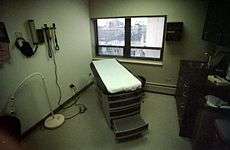Ambulatory care
Ambulatory care or outpatient care is medical care provided on an outpatient basis, including diagnosis, observation, consultation, treatment, intervention, and rehabilitation services. This care can include advanced medical technology and procedures even when provided outside of hospitals.[1][2][3][4][5]
Ambulatory care sensitive conditions (ACSC) are health conditions where appropriate ambulatory care prevents or reduces the need for hospital admission (or inpatient care), such as diabetes or chronic obstructive pulmonary disease.[6]
Many Medical Investigations and treatments for acute and chronic illnesses and preventive health care can be performed on an ambulatory basis, including minor surgical and medical procedures, most types of dental services, dermatology services, and many types of diagnostic procedures (e.g. blood tests, X-rays, endoscopy and biopsy procedures of superficial organs). Other types of ambulatory care services include emergency visits, rehabilitation visits, and in some cases telephone consultations.[7]
Ambulatory care services represent the most significant contributor to increasing hospital expenditures and to the performance of the health care system in most countries, including most developing countries.[8][9]
Settings
Health care organizations use different ways to define the nature of care provided as "ambulatory" versus inpatient or other types of care.[7][8][10][11]
Sites where ambulatory care can be delivered include:

- Doctor's surgeries (known as doctor's offices in American English): This is the most common site for the delivery of ambulatory care in many countries, and usually consists of a physician's visit. Physicians of many specialties deliver ambulatory care. These physicians include specialists in family medicine, internal medicine, obstetrics, gynaecology, cardiology, gastroenterology, endocrinology, ophthalmology, and dermatology.
- Clinics: Including ambulatory care clinics, polyclinics, ambulatory surgery centers, and urgent care centers.
- In the United States, the Urgent Care Association of America (UCAOA) estimates that over 15,000 urgent care centers deliver urgent care services. These centers are designed to evaluate and treat conditions that are not severe enough to require treatment in a hospital emergency department but still require treatment beyond normal physician office hours or before a physician appointment is available.
- In Russia and other countries of the former Soviet Union, Feldsher health stations are the main site for ambulatory care in rural areas.[12]
- Hospitals: Including emergency departments and other hospital-based services such as same day surgery services and mental health services.
- Hospital emergency departments: Some visits to emergency departments result in hospital admission, so these would be considered emergency medicine visits rather than ambulatory care. Most visits to hospital emergency departments, however, do not require hospital admission.
- Non-medical institution-based settings: Including school and prison health; vision, dental and pharmaceutical care.
- Non-institution settings: For example, mass childhood immunization campaigns using community health workers.[9]
Conditions
Ambulatory care sensitive conditions (ACSC) are illnesses or health conditions where appropriate ambulatory care prevents or reduces the need for hospital admission. Appropriate care for an ACSC can include one or more planned revisits to settings of ambulatory care for follow-up, such as when a patient is continuously monitored or otherwise advised to return when (or if) symptoms appear or reappear.
Relatively common ACSC include:[6][13][14][15][16]
|
|
Hospitalization for an ACSC is considered to be a measure of access to appropriate primary health care, including preventive and disease management services. While not all admissions for these conditions are avoidable, appropriate ambulatory care could help prevent their onset, control an acute episode, or manage a chronic disease or condition.:[6][13][14] For Medicaid-covered and uninsured U.S. hospital stays in 2012, six of the top ten diagnoses were ambulatory care sensitive conditions.[17]
See also
References
- ↑ http://www.wisegeek.org/what-is-ambulatory-care.htm
- ↑ http://www.medicinenet.com/script/main/mobileart.asp?articlekey=2218
- ↑ William Osler Health System. What is "Ambulatory Care"? Accessed 25 July 2011.
- ↑ Saskatoon Health Region. Programs & Services: Ambulatory Care. Accessed 25 July 2011.
- ↑ The Free Dictionary. Ambulatory care. Accessed 25 July 2011.
- 1 2 3 Canadian Institute for Health Information, Ambulatory Care Sensitive Conditions. Accessed 14 April 2014.
- 1 2 Canadian Institute for Health Information, Comprehensive Ambulatory Care Classification System. Accessed 25 July 2011.
- 1 2 Karpiel MS. "Using patient classification systems to identify ambulatory care costs." CBS Business Network. Accessed 25 July 2011.
- 1 2 Berman P. "Organization of ambulatory care provision: a critical determinant of health system performance in developing countries." Bulletin of the World Health Organization, 2000, 78(6).
- ↑ Verran JA. "Testing a classification instrument for the ambulatory care setting." Research in Nursing & Health, 9(4): 279–87, December 1986 - doi:10.1002/nur.4770090404
- ↑ Alberta Health and Wellness. Alberta Ambulatory Care Reporting Manual. Edmonton, April 2009.
- ↑ Shabarova Z. Primary Health Care in the NIS: Soviet Primary Health Care system review. Accessed 25 July 2011.
- 1 2 Manitoba Centre for Health Policy and Evaluation (2007-09-26). Concept: Ambulatory Care Sensitive (ACS) Conditions. Published September 26, 2007. Retrieved on 2014-04-14 from http://mchp-appserv.cpe.umanitoba.ca/viewConcept.php?conceptID=1023.
- 1 2 Commonwealth Fund (date unknown). Hospitalizations for Ambulatory Care–Sensitive Conditions. Retrieved on 2014-04-14 from http://www.commonwealthfund.org/Performance-Snapshots/Overuse-of-Health-Care-Services/Hospitalizations-for-Ambulatory-Care--8211-Sensitive-Conditions.aspx.
- ↑ Lui CK, Wallace SP, A common denominator: calculating hospitalization rates for ambulatory care–sensitive conditions in California. Prev Chronic Dis 2011;8(5): A102. Accessed April 14, 2014.
- ↑ Zahid Ansari1 et al., Patient characteristics associated with hospitalisations for ambulatory care sensitive conditions in Victoria, Australia. BMC Health Services Research 2012, 12:475 doi:10.1186/1472-6963-12-475.
- ↑ Lopez-Gonzalez L, Pickens GT, Washington R, Weiss AJ (October 2014). "Characteristics of Medicaid and Uninsured Hospitalizations, 2012". HCUP Statistical Brief #183. Rockville, MD: Agency for Healthcare Research and Quality.
External links
| Wikimedia Commons has media related to Ambulatory care. |
- Urgent Care Association of America
- Journal of Ambulatory Pediatrics
- Diagnosing and treating the ailments of outpatient facilities
- High use of ambulatory care as indication of problems obtaining access to appropriate primary care